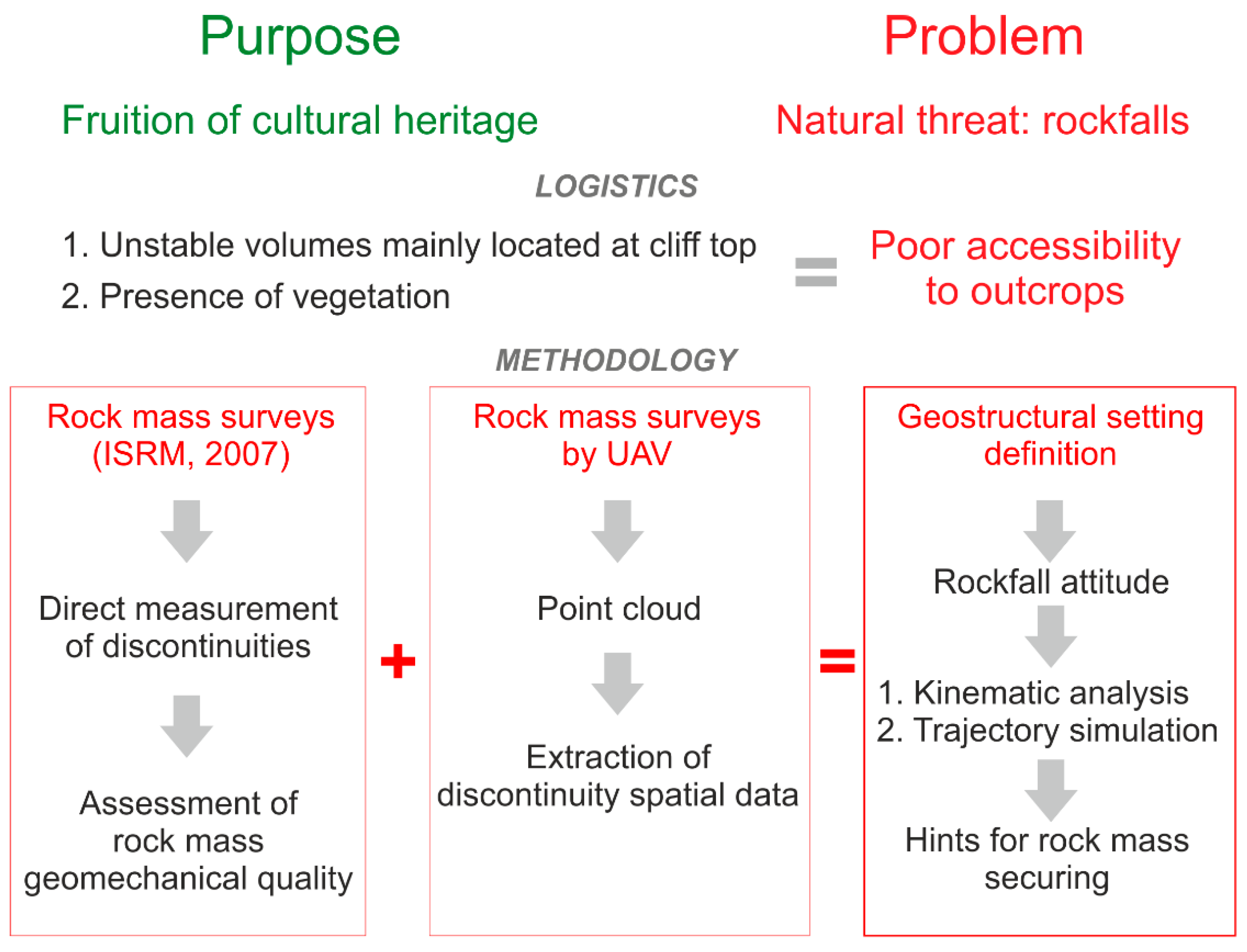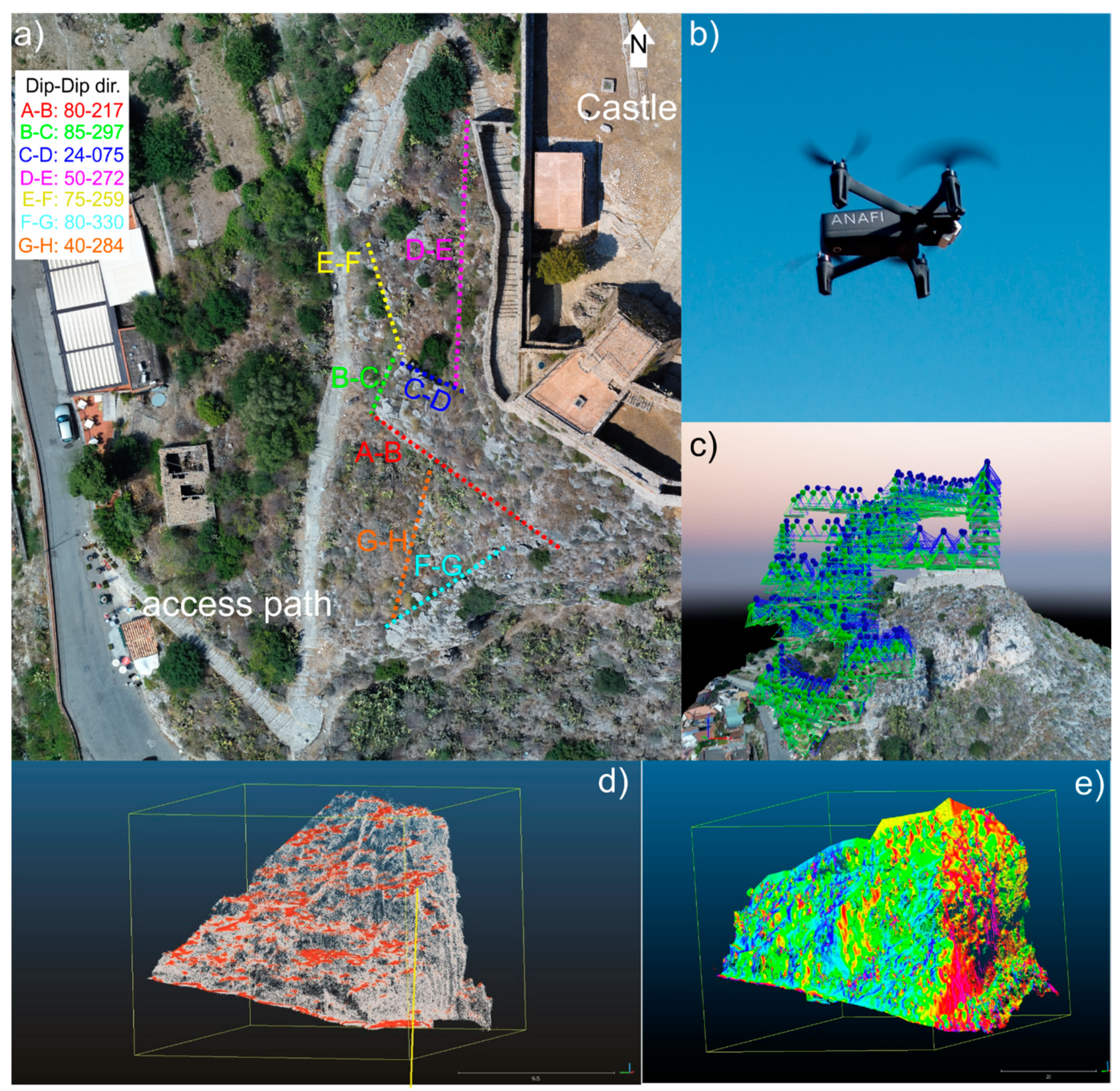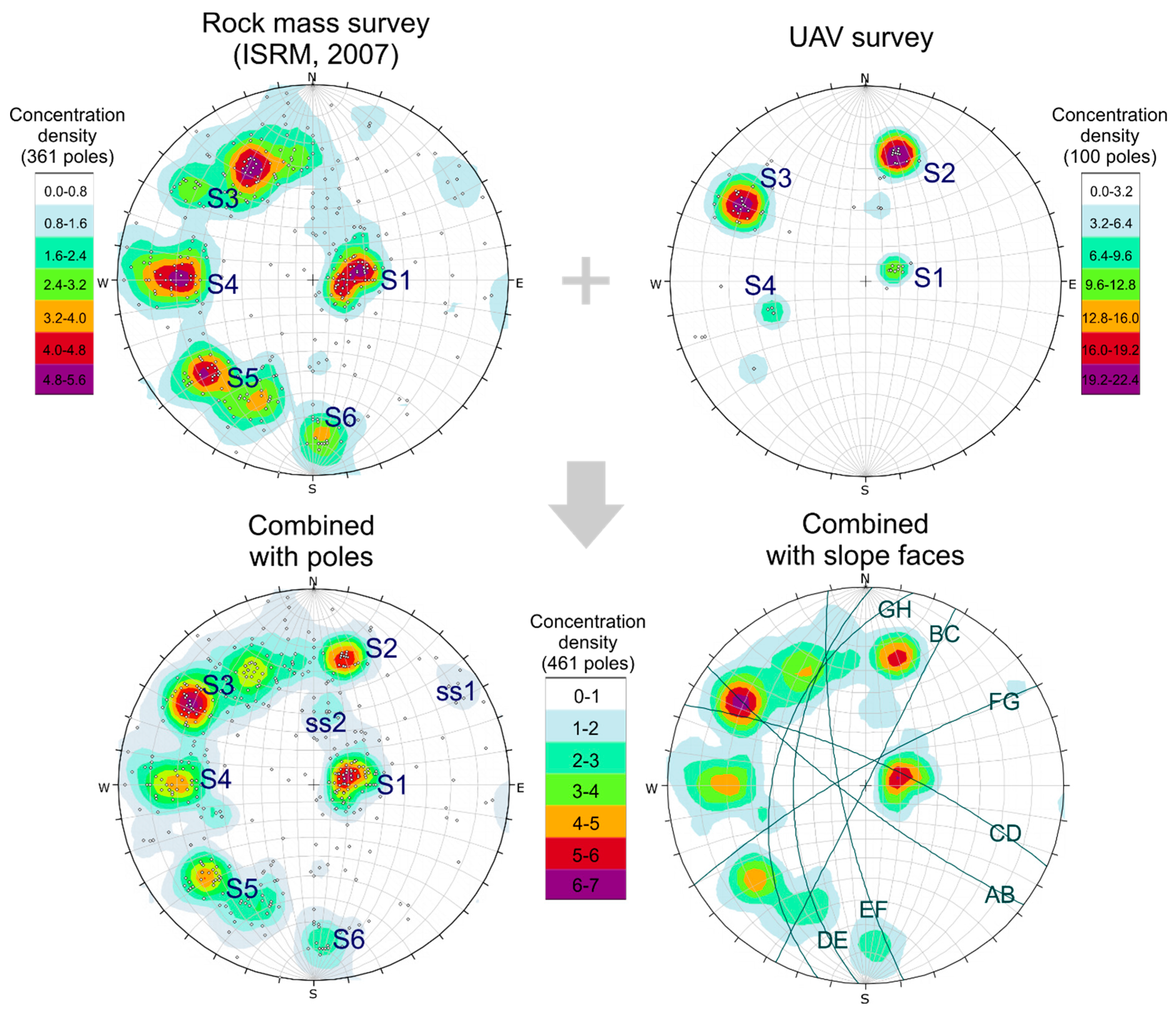Geomechanical Characterization of a Rock Cliff Hosting a Cultural Heritage through Ground and UAV Rock Mass Surveys for Its Sustainable Fruition
Abstract
1. Introduction
2. Setting of the Study Area: Cultural Heritage, Geology and Rockfalls
3. Methodological Approach
4. Results
4.1. Rock Mass Surveys
4.2. Rockfall Attitude
5. Discussion and Conclusions
Author Contributions
Funding
Informed Consent Statement
Data Availability Statement
Acknowledgments
Conflicts of Interest
References
- Canuti, P.; Casagli, N.; Fanti, R.; Iotti, A.; Pecchioni, E.; Santo, A.P. Rock weathering and failure of the “Tomba della Sirena” in the Etruscan necropolis of Sovana (Italy). J. Cult. Herit. 2004, 5, 323–330. [Google Scholar] [CrossRef]
- Canuti, P.; Margottini, C.; Fanti, R.; Bromhead, E.N. Cultural Heritage and Landslides: Research for Risk Prevention and Conservation. In Landslides—Disaster Risk Reduction; Sassa, K., Canuti, P., Eds.; Springer: Berlin, Germany, 2009; pp. 401–433. [Google Scholar] [CrossRef]
- Lollino, G.; Audisio, C. UNESCO World Heritage sites in Italy affected by geological problems, specifically landslide and flood hazard. Landslides 2006, 3, 311–321. [Google Scholar]
- Roberts, N. Canada Culture and landslide risk in the Central Andes of Bolivia and Peru. Stud. Univ. Babes Bolyai Geol. 2009, 54, 55–59. [Google Scholar] [CrossRef][Green Version]
- Fanti, R.; Gigli, G.; Lombardi, L.; Tapete, D.; Canuti, P. Terrestrial laser scanning for rockfall stability analysis in the cultural heritage site of Pitigliano (Italy). Landslides 2012, 10, 409–420. [Google Scholar] [CrossRef]
- Tarragüel, A.A.; Krol, B.; Van Westen, C. Analysing the possible impact of landslides and avalanches on cultural heritage in Upper Svaneti, Georgia. J. Cult. Heritage 2012, 13, 453–461. [Google Scholar] [CrossRef]
- Pappalardo, G.; Imposa, S.; Mineo, S.; Grassi, S. Evaluation of the stability of a rock cliff by means of geophysical and geomechanical surveys in a cultural heritage site (south-eastern Sicily). Ital. J. Geosci. 2016, 135, 308–323. [Google Scholar] [CrossRef]
- Pappalardo, G.; Imposa, S.; Barbano, M.S.; Grassi, S.; Mineo, S. Study of landslides at the archaeological site of Abakainon necropolis (NE Sicily) by geomorphological and geophysical investigations. Landslides 2018, 15, 1279–1297. [Google Scholar] [CrossRef]
- Bunce, C.M.; Cruden, D.M.; Morgenstern, N.R. Assessment of the hazard from rockfall on a highway. Can. Geotech. J. 1997, 34, 344–356. [Google Scholar]
- Evans, S.; Hungr, O. The assessment of rockfall hazard at the base of talus slopes. Can. Geotech. J. 1993, 30, 620–636. [Google Scholar] [CrossRef]
- Pierson, L.A.; Davis, S.A.; Van Vickle, R. Rockfall Hazard Rating System—Implementation Manual, Federal Highway Administration (FHWA); Report FHWAOR- EG-90–01; FHWA, US Department of Transportation: Washington, DC, USA, 1990.
- Briones-Bitar, J.; Carrión-Mero, P.; Montalván-Burbano, N.; Morante-Carballo, F. Rockfall Research: A Bibliometric Anal-ysis and Future Trends. Geosciences 2020, 10, 403. [Google Scholar]
- Scavia, C.; Barbero, M.; Castelli, M.; Marchelli, M.; Peila, D.; Torsello, G.; Vallero, G. Evaluating Rockfall Risk: Some Critical Aspects. Geosciences 2020, 10, 98. [Google Scholar] [CrossRef]
- Mineo, S.; Pappalardo, G.; Mangiameli, M.; Campolo, S.; Mussumeci, G. Rockfall Analysis for Preliminary Hazard Assessment of the Cliff of Taormina Saracen Castle (Sicily). Sustainability 2018, 10, 417. [Google Scholar] [CrossRef]
- Mineo, S.; Pappalardo, G. Sustainable Fruition of Cultural Heritage in Areas Affected by Rockfalls. Sustainability 2020, 12, 296. [Google Scholar] [CrossRef]
- Glade, D. Unmanned Aerial Vehicles: Implications for Military Operations; Air University Maxwell Air Force Base: Montgomery, AL, USA, 2000. [Google Scholar]
- Chiabrando, F.; Lingua, A.; Rinaudo, F.; Spanò, A. Archaeological site monitoring: UAV photogrammetry could be an answer. In Proceedings of the International Archives of Photogrammetry, Remote Sensing and Spatial Information Sciences, Melbourne, VIC, Australia, 25 August–1 September 2012. [Google Scholar]
- Piras, M.; Taddia, G.; Forno, M.G.; Gattiglio, M.; Aicardi, I.; Paolo, D.; Russo, S.L.; Maria, L.A. Detailed geological mapping in mountain areas using an unmanned aerial vehicle: Application to the Rodoretto Valley, NW Italian Alps. Geomat. Nat. Hazards Risk 2016, 8, 137–149. [Google Scholar] [CrossRef]
- Coifman, B.; Mccord, M.; Mishalani, R.G.; Iswalt, M.; Ji, Y. Roadway traffic monitoring from an unmanned aerial vehicle. IEE Proc. Intell. Transp. Syst. 2006, 153, 11. [Google Scholar] [CrossRef]
- Karantanellis, E.; Marinos, V.; Vassilakis, E.; Christaras, B. Object-Based Analysis Using Unmanned Aerial Vehicles (UAVs) for Site-Specific Landslide Assessment. Remote Sens. 2020, 12, 1711. [Google Scholar] [CrossRef]
- Sarro, R.; Riquelme, A.; López-Davalillo, J.C.G.; Mateos, R.M.; Tomás, R.; Pastor, J.L.; Gonzalez, M.C.; Herrera, G. Rockfall Simulation Based on UAV Photogrammetry Data Obtained during an Emergency Declaration: Application at a Cultural Heritage Site. Remote Sens. 2018, 10, 1923. [Google Scholar] [CrossRef]
- Francioni, M.; Simone, M.; Stead, D.; Nicola, S.; Mataloni, G.; Calamita, F. A New Fast and Low-Cost Photogrammetry Method for the Engineering Characterization of Rock Slopes. Remote Sens. 2019, 11, 1267. [Google Scholar] [CrossRef]
- Nex, F.; Remondino, F. UAV for 3D mapping applications: A review. Appl. Geomat. 2014, 6, 1–15. [Google Scholar] [CrossRef]
- Vacca, G.; Dessì, A.; Sacco, A. The Use of Nadir and Oblique UAV Images for Building Knowledge. ISPRS Int. J. Geo Inf. 2017, 6, 393. [Google Scholar] [CrossRef]
- Greenwood, W.; Zekkos, D.; Lynch, J.; Bateman, J.; Clark, M.K.; Chamlagain, D. UAV-Based 3-D Characterization of Rock Masses and Rock Slides in Nepal. In Proceedings of the 50th ARMA U.S. Rock Mechanics/Geomechanics Symposium, Houston, TX, USA, 26–29 June 2016; pp. 16–678. [Google Scholar]
- Brückl, E.; Brunner, F.K.; Kraus, K. Kinematics of a deep-seated landslide derived from photogrammetric, GPS and geo-physical data. Eng. Geol. 2006, 88, 149–159. [Google Scholar]
- Collins, B.D.; Stock, G.M. Lidar-Based Rock-Fall Hazard Characterization of Cliffs. In GeoCongress 2012: State of the Art and Practice in Geotechnical Engineering, Proceedings of GeoCongress 2012, Oakland, CA, USA, 25–29 March 2012; Hryciw, R.D., Athanasopoulos-Zekkos, A., Yesiller, N., Eds.; American Society of Civil Engineers: Reston, VA, USA, 2012; pp. 3021–3030. [Google Scholar] [CrossRef]
- Vöge, M.; Lato, M.J.; Diederichs, M.S. Automated rockmass discontinuity mapping from 3-dimensional surface data. Eng. Geol. 2013, 164, 155–162. [Google Scholar] [CrossRef]
- Gigli, G.; Casagli, N. Semi-automatic extraction of rock mass structural data from high resolution LIDAR point clouds. Int. J. Rock Mech. Min. Sci. 2011, 48, 187–198. [Google Scholar] [CrossRef]
- Sturzenegger, M.; Stead, D. Quantifying discontinuity orientation and persistence on high mountain rock slopes and large landslides using terrestrial remote sensing techniques. Nat. Hazards Earth Syst. Sci. 2009, 9, 267–287. [Google Scholar] [CrossRef]
- Riquelme, A.J.; Abellán, A.; Tomás, R. Discontinuity spacing analysis in rock masses using 3D point clouds. Eng. Geol. 2015, 195, 185–195. [Google Scholar] [CrossRef]
- Mancini, F.; Castagnetti, C.; Rossi, P.; Dubbini, M.; Fazio, N.; Perrotti, M.; Allasia, P. An Integrated Procedure to Assess the Stability of Coastal Rocky Cliffs: From UAV Close-Range Photogrammetry to Geomechanical Finite Element Modeling. Remote Sens. 2017, 9, 1235. [Google Scholar] [CrossRef]
- Salvini, R.; Mastrorocco, G.; Seddaiu, M.; Rossi, D.; Vanneschi, C. The use of an unmanned aerial vehicle for fracture mapping within a marble quarry (Carrara, Italy): Photogrammetry and discrete fracture network modelling. Geomatics, Nat. Hazards Risk 2017, 8, 34–52. [Google Scholar] [CrossRef]
- Danzi, M.; Di Crescenzo, G.; Ramondini, M.; Santo, A. Use of unmanned aerial vehicles (UAVs) for photogrammetric surveys in rockfall instability studies. Rendiconti Online Societa Geologica Italiana 2013, 24–82, 85. [Google Scholar]
- Loiotine, L.; Liso, I.S.; Parise, M.; Andriani, G.F. Optimization of Geostructural Surveys In Rock Mass Stability Analyses Using Remote Sensing Techniques. Ital. J. Eng. Geol. Environ. 2019, 73–78, Special Issue 1. [Google Scholar] [CrossRef]
- Robiati, C.; Eyre, M.; Vanneschi, C.; Francioni, M.; Venn, A.; Coggan, J. Application of Remote Sensing Data for Evaluation of Rockfall Potential within a Quarry Slope. ISPRS Int. J. Geo Inf. 2019, 8, 367. [Google Scholar] [CrossRef]
- Rodriguez, J.; Macciotta, R.; Hendry, M.T.; Roustaei, M.; Gräpel, C.; Skirrow, R. UAVs for monitoring, investigation, and mitigation design of a rock slope with multiple failure mechanisms—A case study. Landslides 2020, 17, 2027–2040. [Google Scholar] [CrossRef]
- Argeri, G. Storia di San Piero Patti: Attraverso gli Avvenimenti più Importanti della Sicilia; Scuola Grafica Salesiana: Palermo, Italy, 1984. [Google Scholar]
- Lentini, F.; Carbone, S.; Guarnieri, P. Collisional and postcollisional tectonics of the Apenninic-Maghrebian orogen (southern Italy). In Geological Society of America Special Paper 409; Geological Society of America: Boulder, CO, USA, 2006; pp. 57–81. [Google Scholar]
- Ferrara, V.; Pappalardo, G. Kinematic analysis of rock falls in an urban area: The case of Castelmola hill near Taormina (Sicily, Italy). Geomorphology 2005, 66, 373–383. [Google Scholar] [CrossRef]
- Mineo, S.; Pappalardo, G.; D’Urso, A.; Calcaterra, D. Event tree analysis for rockfall risk assessment along a strategic mountainous transportation route. Environ. Earth Sci. 2017, 76, 620. [Google Scholar] [CrossRef]
- Mineo, S. Comparing rockfall hazard and risk assessment procedures along roads for different planning purposes. J. Mt. Sci. 2020, 17, 653–669. [Google Scholar] [CrossRef]
- Pappalardo, G.; Mineo, S.; Rapisarda, F. Rockfall hazard assessment along a road on the Peloritani Mountains (northeastern Sicily, Italy). Nat. Hazards Earth Syst. Sci. 2014, 14, 2735–2748. [Google Scholar] [CrossRef]
- Pappalardo, G.; Mineo, S.; Zampelli, S.P.; Cubito, A.; Calcaterra, D. InfraRed Thermography proposed for the estimation of the Cooling Rate Index in the remote survey of rock masses. Int. J. Rock Mech. Min. Sci. 2016, 83, 182–196. [Google Scholar] [CrossRef]
- Pappalardo, G.; Mineo, S.; Calcaterra, D. Geomechanical Analysis of Unstable RockWedges by Means of Geostructural and Infrared Thermography Surveys. Ital. J. Eng. Geol. Environ. 2017, 93–101. [Google Scholar] [CrossRef]
- Pappalardo, G.; Mineo, S. Rockfall Hazard and Risk Assessment: The Promontory of the Pre-Hellenic Village Castelmola Case, North-Eastern Sicily (Italy). In Engineering Geology for Society and Territory—Volume 2; Lollino, G., Manconi, A., Clague, J., Shan, W., Chiarle, M., Eds.; Springer International Publishing: Cham, Switzerland, 2015; Volume 2, pp. 1989–1993. [Google Scholar] [CrossRef]
- International Society for Rock Mechanics (ISRM). The complete ISRM suggested methods for rock characterization, testing and monitoring: 1974–2006. In Suggested Methods Prepared by the Commission on Testing Methods; Ulusay, R., Hudson, J.A., Eds.; Compilation Arranged by the ISRM Turkish National Group; International Society for Rock Mechanics: Ankara, Turkey, 2007; p. 628. [Google Scholar]
- Bieniawski, Z.T. Engineering Rock Mass Classification; John Wiley & Son: New York, NY, USA, 1989; p. 251. [Google Scholar]
- Romana, M. SMR Classification. In Proceedings of the 7th International Congress on Rock Mechanics, Aachen, Germany, September 1991; Balkema: Rotterdam, The Netherlands, 1991; pp. 955–960. [Google Scholar]
- Koeva, M.; Muneza, M.; Gevaert, C.; Gerke, M.; Nex, F. Using UAVs for map creation and updating. A case study in Rwanda. Surv. Rev. 2016, 1–14. [Google Scholar] [CrossRef]
- Geostru. Georock 3D User Manual; Geostru: Cluj-Napoca, Romania, 2013. [Google Scholar]
- Ansari, M.K.; Ahmed, M.; Singh, R.; Singh, T.N.; Ghalayani, I. Rainfall, A Major Cause for Rockfall Hazard along the Roadways, Highways and Railways on Hilly Terrains in India. In Engineering Geology for Society and Territory; Lollino, G., Manconi, A., Clague, J., Shan, W., Chiarle, M., Eds.; Springer: Cham, Switzerland, 2015; Volume 1. [Google Scholar] [CrossRef]
- Barbano, M.S.; Pappalardo, G.; Pirrotta, C.; Mineo, S. Landslide triggers along volcanic rock slopes in eastern Sicily (Italy). Nat. Hazards 2014, 73, 1587–1607. [Google Scholar] [CrossRef]
- Melillo, M.; Gariano, S.L.; Peruccacci, S.; Sarro, R.; Mateos, R.M.; Brunetti, M.T. Rainfall and rockfalls in the Canary Islands: Assessing a seasonal link. Nat. Hazards Earth Syst. Sci. 2020, 20, 2307–2317. [Google Scholar] [CrossRef]







| Cropping Out Material | Rt | Rn |
|---|---|---|
| Bare rock | 0.80 | 0.50 |
| Rock talus + vegetation | 0.80 | 0.32 |
| Rock debris | 0.65 | 0.15 |
| Asphalt | 0.90 | 0.40 |
| Set (Dip/Dip dir.) | Spacing (mm) | Persistance (m) | Aperture (mm) | JRC | Infilling | Weathering | RMRb Class | SMR Class |
|---|---|---|---|---|---|---|---|---|
| S1 (22/261) | Close to Moderate | Very high | Very tight | 2–8 | none | Slight to Moderate | 47 to 56 III | 53 to 62 III to II |
| S3 (68/135) | Close to Moderate | High | Moderate | 4–12 | soft | Slight to Moderate | ||
| S4 (69/088) | Close | Medium | Very tight to Moderate | 4–10 | none/soft | Slight to Moderate | ||
| S5 (70/038) | Moderate | Medium | Moderate | 14–16 | soft | Moderate | ||
| S6 (76/357) | Moderate | Medium | Moderate | 2–4 | soft | Moderate |
| Slope Face | Unstable Kinematic Pattern at Each Set | |||
|---|---|---|---|---|
| P | W | DT | FT | |
| AB | S1, S2, ss2 r | S1 to S4, S6, ss1, ss2, r | S3 to S6, r (I) S1, ss2, r (BP) | S5, r |
| BC | S1, r | S3, S5, S6, ss1, ss2, r | S2 to S6, ss1, ss2, r (I) S1, r (BP) | S3, S4, r |
| CD | S5, r | S1, S3 to S6, ss1, ss2, r | S2 to S4, ss2, r (I) S1, Se, r (BP) | S2, ss2, r |
| DE | S1, r | S5, ss1, r | S2 to S6, ss1, r (I) S1, S5, r (BP) | S3, S4, r |
| EF | S1, r | S3, S5, S6, ss1, ss2, r | S2 to S6, ss1, r(I) S1, r (BP) | S4, S5, r |
| FG | r | S1, S2, S5, S6, ss1, r | S2 to S5, ss1, ss2, r (I) S1, S6, r (BP) | S3, r |
| GH | S1, r | S5, ss1, r | S2 to S6, ss1, r (I) S1, r (BP) | S3, S4, r |
Publisher’s Note: MDPI stays neutral with regard to jurisdictional claims in published maps and institutional affiliations. |
© 2021 by the authors. Licensee MDPI, Basel, Switzerland. This article is an open access article distributed under the terms and conditions of the Creative Commons Attribution (CC BY) license (http://creativecommons.org/licenses/by/4.0/).
Share and Cite
Mineo, S.; Pappalardo, G.; Onorato, S. Geomechanical Characterization of a Rock Cliff Hosting a Cultural Heritage through Ground and UAV Rock Mass Surveys for Its Sustainable Fruition. Sustainability 2021, 13, 924. https://doi.org/10.3390/su13020924
Mineo S, Pappalardo G, Onorato S. Geomechanical Characterization of a Rock Cliff Hosting a Cultural Heritage through Ground and UAV Rock Mass Surveys for Its Sustainable Fruition. Sustainability. 2021; 13(2):924. https://doi.org/10.3390/su13020924
Chicago/Turabian StyleMineo, Simone, Giovanna Pappalardo, and Salvatore Onorato. 2021. "Geomechanical Characterization of a Rock Cliff Hosting a Cultural Heritage through Ground and UAV Rock Mass Surveys for Its Sustainable Fruition" Sustainability 13, no. 2: 924. https://doi.org/10.3390/su13020924
APA StyleMineo, S., Pappalardo, G., & Onorato, S. (2021). Geomechanical Characterization of a Rock Cliff Hosting a Cultural Heritage through Ground and UAV Rock Mass Surveys for Its Sustainable Fruition. Sustainability, 13(2), 924. https://doi.org/10.3390/su13020924







